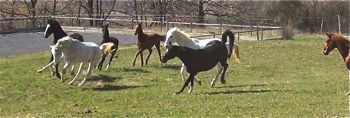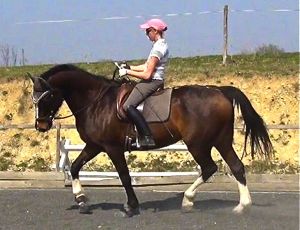

The Intelligence of the HerdSpotlight On Management: Last week we began the integration of our two warmblood foals, Djinnie and Quaramba, into the main herd (click here to see the back issue of the Whole Horse Newsletter which introduces them).
For the last two or three weeks, Djinnie and Quaramba have been in a field which is surrounded by one of the principle Paddock Paradise lanes that is occupied by our main herd of 11 mares and geldings. This way, they have been able to meet and get used to all of the members of the herd gradually before actually being part of the herd. This allowed them to understand the herd structure, and gave a chance for the initial excitement of new encounters to wear off before the foals were in amongst the large group of strange horses. When they were settled in this situation, we began the next step of integration. The first day we simply opened the gate to the foals' field, allowing the herd to come in and meet them on their own familiar ground. This initial meeting was surprisingly calm and uneventful. After an initial gallop on entering the field, the herd seemed to be more occupied with grazing than anything else, seemingly ignoring the foals, who stuck together but didn't show much concern or anxiety about the encounter. Watching this happening repeatedly for an hour or so, it made me think of a kind of 'sowing' process whereby the foals came towards a herd member, and were then in turn sought after by them, as if stitching them gently into the herd.
These herd members were actually channeling the foals into the Paddock Paradise lanes that opened off the fields, and into a corner full of bushes where it was harder for them to flee. In other places, horses were strategically positioned to block the lanes apparently for the same reason. This non-aggressive channeling continued until they gave up running and accepted to walk alongside the others (photo, below). The following day was back to calm again, as the herd seemed to have made its point.
In this new situation - where instead of an adult coming into the herd, it was two defenseless foals - they adapted their behavior to correspond with what was needed for the overall integrity of the herd: not the sustained aggression and rejection that an adult newcomer would normally encounter, and which would have traumatized the foals, but instead a subtle combination of active pressuring for them to become part of the herd, and periods of leaving them alone to make their own decisions. The Parallels with Training There are very well known natural horsemanship techniques which have been inspired by certain aspects of wild horse behavior. The most popularized example is that of the Monty Roberts Join-up method, which is effectively a simulation by the trainer of the wild horses' aggressive sending-away of a newcomer to the herd, or of a horse who doesn't accept his ranking. 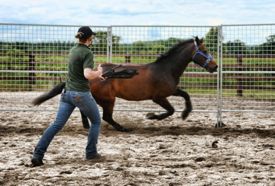 This may be an effective way of achieving the submission of most horses, but the behavior of our herd with the youngsters shows that an aggressive approach is not always appropriate. Just because a horse submits to us and 'joins-up' doesn't necessarily mean that we have gained his trust. He may have stopped trying to escape because he has realized that submission is the only way out of the situation (like a horse trapped between harsh spurs and double bridle) but that doesn't mean he has truly given himself over to us. The fear and tension may become less obvious in such a horse, but they don't go away, and they often transform themselves into physical stiffness over time, or turn into another form of resistance.
This may be an effective way of achieving the submission of most horses, but the behavior of our herd with the youngsters shows that an aggressive approach is not always appropriate. Just because a horse submits to us and 'joins-up' doesn't necessarily mean that we have gained his trust. He may have stopped trying to escape because he has realized that submission is the only way out of the situation (like a horse trapped between harsh spurs and double bridle) but that doesn't mean he has truly given himself over to us. The fear and tension may become less obvious in such a horse, but they don't go away, and they often transform themselves into physical stiffness over time, or turn into another form of resistance.
As well as being non-aggressive with the foals, our herd's behavior also showed the importance of taking it slowly, especially to begin with. In the same way, just because it is possible to back a horse from scratch in an afternoon, does not mean that it is the best way to gain a young horse's trust, not to mention the drastic gymnastic disadvantage of not strengthening a horse properly in preparation for being ridden. 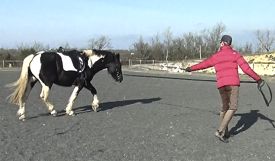 Knowing the right way to proceed in the training of a young horse comes down to your ability to tap into the same intuitive intelligence that the horses in a herd use to judge a situation. Every horse is different, and a training technique that may work well on a confident horse would terrorize a nervous one. This is why sensitivity and patience are the horse trainer's best tools.
Knowing the right way to proceed in the training of a young horse comes down to your ability to tap into the same intuitive intelligence that the horses in a herd use to judge a situation. Every horse is different, and a training technique that may work well on a confident horse would terrorize a nervous one. This is why sensitivity and patience are the horse trainer's best tools.
Good training is not about doing things as quickly as possible by means of submission that is achieved through fear. Good training is taking the time to build a deep trust between you and your horse, and the correct gymnastic preparation that goes along with that.
New pages on HHT: The Psoas Muscle And Its Importance in Riding HHT Products: The Simple Seven-Step Natural Trim eBook Learn how to perform the ideal barefoot trim with this comprehensive how-to guide. Click here to visit Happy Horse Training New! CommentsAnything to say about this page? Leave your comment in the box below. |
Join the Whole Horse Newsletter
HHT's free monthly newsletter giving you wide-ranging and intelligent insights into holistic horsemanship.
Just enter your details below to join.
Free bonus on the riding position with all new subscriptions: Ten Top Tips To Instantly Improve Your Connection With Your Horse.
Train Your Horse
The Holistic Way
How To Train A Horse Without Force is a unique guide to training horses through energetic connection and gymnastic training. Part 1 covers everything on the ground, from handling to the lungeing technique that develops strength, straightness and engagement. Comes with a free eBook supplement on Horse Trauma.
Click here for more details.
Do You Have
A Horse Story
To Share On HHT?
So many people have been through wonderful experiences with horses, whether in training or otherwise. If you've made a change in a horse's life - or one has made a change in yours - tell us about it here.
Learn How To Trim
Your Own Horse's Feet
The Simple Seven-Step Natural Trim is a comprehensive step-by-step guide to a cutting-edge barefoot trim. Click here to find out more.
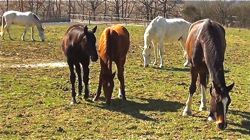
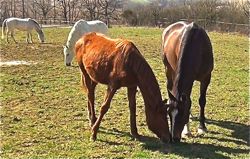
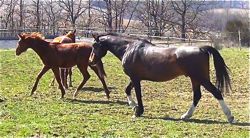
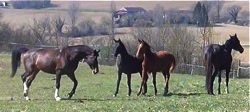 There was none of the aggression that is often shown to new adult members by the lower-ranking horses trying to defend their place in the herd. In the foals' case it was the higher ranking herd members that were involved with minimal tension and no aggressive chasing.
There was none of the aggression that is often shown to new adult members by the lower-ranking horses trying to defend their place in the herd. In the foals' case it was the higher ranking herd members that were involved with minimal tension and no aggressive chasing.

